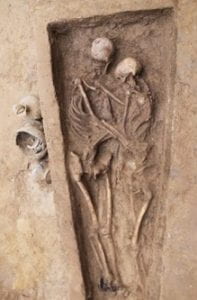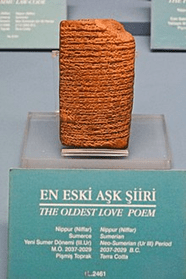
Valentine’s Day is fast approaching, and we are here to gear you up with some archaeological and historical related material to prepare you for this candy-giving, love-spreading holiday! As many know, the origin of Valentine’s Day is rooted both in the Catholic Saint from whom it is named after as well as secular customs. The exact details of how the martyrdom of St. Valentine led to the holiday we celebrate today are not well-known, but the tales are similar. Three different St. Valentines actually share February 14th as their feast day, with the first being a priest and physician in Rome during the third century who is said to have been condemned to death by Emperor Claudius II after either aiding martyrs or by performing marriages after the emperor had outlawed them due to the belief that unmarried men made better soldiers. Another story states that he was a Bishop, Saint Valentine of Terni, who was ordered by Emperor Claudius II to be arrested, beaten, and beheaded as well. The third St. Valentine is said to have served in and become a martyr in Africa, but not much else is known about this saint.

Some legends continue that either the St. Valentine of Rome or the St. Valentine of Terni, while in jail before their executions, signed a letter to the jailer’s daughter whom they had befriended with “From your Valentine,” thus leading to the commonly used expression today. St. Valentine is said to have been buried on the Flaminian way, with Pope Julius I (AD 333-356) building a basilica at the site, preserving his tomb. Archaeological excavations during the 1500s and 1800s at the basilica found evidence of the tomb of St. Valentine, most likely the St. Valentine of Rome, and relics were transferred to the Church of Saint Praxedes in the 13th century, where they remain today. Although each story is slightly different, the underlying themes of the legends are similar.
Around the world, people celebrate St. Valentine in a variety of ways. Of course, we know that Americans typically send cards or letters, chocolate, and flowers to their sweethearts, friends, and family on February 14th. In Denmark, on the same day, friends and sweethearts exchange white flowers called snowdrops and “joking letters” or gaekkebrev, a funny poem or rhyme written on a paper with cut decorations and lacking a signature, with only a number of dots corresponding to the number of letters in the anonymous sender’s name. If you can guess the sender, you will later receive an Easter egg on Easter Sunday, but if you do not, you owe the sender one.  In South Korea February 14th was originally a day for women to give chocolate to men as a sign of affection, but marketing has changed it more into a couple’s day. However, on March 14th, also called White Day, men then give women primarily white gifts to answer the Valentine’s Day gifts. And finally, on Black Day, April 14th, singles who did not receive a gift on either of the prior days, eat jjajangmyeon, or Black Noodles. Brazil’s Valentine’s Day is known as Dia dos Namorados, or “Lovers’ Day,” “Day of the Enamored,” or “Boyfriends’/Girlfriends’ Day,” and it is actually celebrated on June 12th. They celebrate on that day due to its’ proximity to St. Anthony’s Day on June 13th, a Saint in Brazil believed to bless young couples with a prosperous marriage. They too, like Americans exchange gifts, flowers, and chocolates, as well as have grand dinners.
In South Korea February 14th was originally a day for women to give chocolate to men as a sign of affection, but marketing has changed it more into a couple’s day. However, on March 14th, also called White Day, men then give women primarily white gifts to answer the Valentine’s Day gifts. And finally, on Black Day, April 14th, singles who did not receive a gift on either of the prior days, eat jjajangmyeon, or Black Noodles. Brazil’s Valentine’s Day is known as Dia dos Namorados, or “Lovers’ Day,” “Day of the Enamored,” or “Boyfriends’/Girlfriends’ Day,” and it is actually celebrated on June 12th. They celebrate on that day due to its’ proximity to St. Anthony’s Day on June 13th, a Saint in Brazil believed to bless young couples with a prosperous marriage. They too, like Americans exchange gifts, flowers, and chocolates, as well as have grand dinners.

The Lovers of Valdaro

The skeleton’s of the embracing couple from the Northern Wei period (International Journal of Osteoarchaeology).
Here are some romantic archaeological discoveries that are sure to make you believe in true love this upcoming Valentine’s Day. The “Lovers of Valdaro,” the Neolithic, entangled, male and female corpses from 6,000 years ago found in Mantua, Italy in 2007, are well-known figures representing “eternal love”, despite evidence that they were positioned in this way after death because they were buried in a necropolis. In 2021 in the city of Datong, Shanxi Province, China, the remains of a man and women wrapped in an embrace were discovered while excavating more than 600 tombs at a cemetery uncovered during construction work. They lived during the Northern Wei period (386 to 534 A.D.), another example of “embracing each other for eternal love during the afterlife.” Similar intimate burials include the skeletons dating to 5,800 years ago found at Alepotrypa, a cave in Laconia, Greece, the double burials of the Bronze Age Vysotskaya culture in the Ukraine, the two 14th century skeletons holding hands at a site in Leicestershire, England, dozens of Bronze Age couple burials belonging to the Andronovo culture found in Siberia, and many more.
Other romantic discoveries must include love letters. Archaeologists in South Korea found several in a tomb by the mummified body of a 16th century male named Eung-tae, a member of Korea’s ancient Goseong Yi clan. His pregnant wife wrote them around 1568 A.D., expressing her grief and hope of seeing him in her dreams. A 4,000-year-old Sumerian clay tablet called Istanbul #2461 or “The Love Song for Shu-Sin,” holds the Guinness World Record for being the oldest surviving love poem. It is currently held at the Istanbul Museum of the Ancient Orient in Turkey. Dating to around 2025 B.C., it contains a ballad written by the priestess bride professing her love the king Shu-Sin. It is also postulated that this ballad is part of a sacred rite or ‘sacred marriage’ that takes place each year, for a ceremonial and symbolic marriage to the goddess Inanna (the goddess of fertility and sexual love) through one of her priestesses, to make both soil and women fertile.
There are many more symbols of love found amongst archaeological sites, carved into monuments and stone, evident in ancient rings, described and depicted on fading papers, all remnants of the universally shared emotion. As Valentine’s Day approaches, and you receive candy hearts and vibrant red roses, perhaps ponder how archaeologists hundreds or thousands of years from now will interpret the professions of love that you left behind! Have a Happy Valentine’s Day!
Follow IUP Anthropology on Facebook, Twitter, and Instagram
Further Reading:

